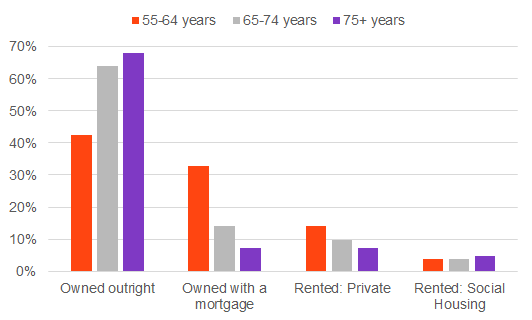This blog is the third in our series on housing consumption patterns, looking at how our older population would prefer to live and their housing aspirations.
If you work in local government and would like to learn more about the housing preferences of different demographic cohorts in your area, speak with our housing team or download a copy of the housing report starter guide – a step-by-step guide to finding and compiling this information from publicly-available sources.
Those aged over 55 years are generally well established in their lives – if they had children they are generally older and moving out of home, careers are established and perhaps looking towards retirement, and most are living in their own home. However those aged 55 are quite different to those over the age of 75, so I’ve broken down this analysis to look at 3 different groups, 55-64 years, 65-74 years and those over 75 years.
So how are people aged over 55 years in Australia living? The data shows that the living arrangements for 55-74-year-olds is fairly similar – the vast majority are living as a couple. However, after age 75, things start to change a little. From this age onwards, sadly one partner of a couple may die, leaving a lone person household. You can also start to see some older people starting to live with their children – almost 4% of those aged over 75 across Australia.
Living arrangements of those aged over 55 years, Australia, 2016

Source: ABS Census of Population and Housing, 2016
What types of housing does the older population live in?
Australia’s older population generally live in separate houses, which is reflective of Australia’s dwelling stock overall, but also of the type of stock being built in the 1950s-1990s when these age groups were entering the housing market. However, there is some evidence of older people living in smaller dwelling formats, especially those aged over 75 years. It should also be said at this point that for those aged over 75, 1 in 10 are living in an aged care facility.
Housing consumption patterns of those aged over 55 years, Australia, 2016

Source: ABS Census of Population and Housing, 2016
The main difference within the older age groups is around the number of bedrooms in the dwellings they live in. The likelihood to live in a large dwelling, with 4 or more bedrooms decreases with age. This could be evidence of downsizing, but also the influence of the size of dwellings being built in each era – the dominance of 4 bedroom homes is a recent phenomenon.
Number of bedrooms in dwellings occupied by those aged over 55 years, Australia, 2016

Source: ABS Census of Population and Housing, 2016
Again, tenure type changes with age. Those aged 55-64 years are more likely to still have a mortgage, however most mortgages are paid off by the time people enter the 65-74 years age group. There are few renters, but this is a very vulnerable group to financial stress as they enter retirement.
Tenure type of those aged over 55 years, Australia, 2016

Source: ABS Census of Population and Housing, 2016
Is this what they truly want to be living in?
The Australian Housing and Urban Research Institute recently undertook the Australian Housing Aspirations survey with the goal of answering this question.
The survey found that for many aged over 55 years, their short term housing aspirations were met by their current living arrangements. However, when looking at longer term aspirations, the older age groups (65+ years) are less confident that their current housing will meet their long term needs. By this age, a number of survey respondents indicated they would like a smaller dwelling, 2 or 3 bedrooms, and ideally to own it outright, for the financial security. Yet there were also a number of respondents that wanted to remain in their larger family home, only leaving if they’re “in a wooden box”.
The fact that our older population have such a wide range of preferences supports the notion that providing a high level of housing diversity in your local market is the best way to cater to your population.
While these sorts of insights are unfortunately not available at an LGA level, Australia-wide surveys do shed some light on the types of aspirations older people living in your area may have. If you work in local government and would like more information.
You can always find out more about how young people in your area are currently living.
Check out the services on offer from our housing team.













